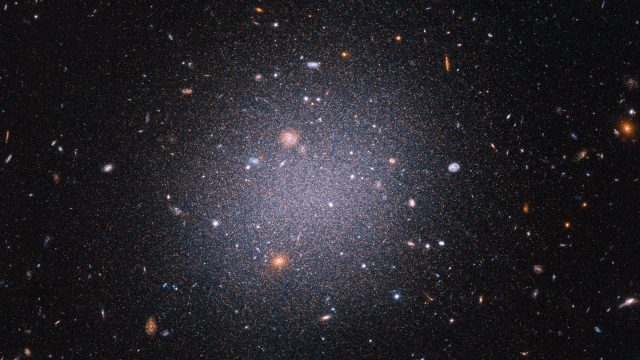In 2018, a team of astronomers reported that a galaxy appeared to have no dark matter, the invisible, mysterious stuff that is known only from its gravitational effects. The team’s work was met with scepticism, but now, they’ve doubled-down on the hypothesis after additional observations of the galaxy using the Hubble Space Telescope.
Many galaxies are huge spiral formations, like our Milky Way, or elliptical, like M87 of black hole fame. But this galaxy, called DF2 for short, lacks any of that density. It is ultra-diffuse, meaning that it has the mass of a smaller galaxy but much more spread out. DF2 is as wide as the Milky Way but contains just half a per cent as many stars. A research team suggested in 2018 that DF2’s ultra-diffuseness might be explained by an absence of dark matter, which is often referred to as the “glue” holding galaxies together. But other astronomers weren’t convinced, arguing that the data wasn’t strong enough to reach such a conclusion.
The team’s second round of results have been published this month in the Astrophysical Journal Letters, and they refine the measurement of the galaxy’s distance from Earth, which has implications for how dark matter-less DF2 truly might be.
“We went out on a limb with our initial Hubble observations of this galaxy in 2018,” said Pieter van Dokkum, an astronomer at Yale University and a co-author of the new paper, in a NASA statement. “I think people were right to question it because it’s such an unusual result. It would be nice if there were a simple explanation, like a wrong distance. But I think it’s more fun and more interesting if it actually is a weird galaxy.”
Dark matter has yet to be directly observed (and there are various candidates to explain it, from primordial black holes to theoretical particles like axions), but astronomers see the gravitational signature of the stuff when they look at how fast galaxies rotate compared to how much visible matter they have. That cannot be said for DF2, though, where the observable stars seem to account for most of the galaxy’s gravity.
Some criticisms of the original paper focused on the galaxy’s brightness: If the researchers had gotten the distance wrong in their measurements, the galaxy could be closer than thought and therefore have fewer stars than implied by its brightness. Fewer stars would mean that less of DF2’s gravity could be attributed to visible matter, and thus it must have more dark matter to hold the structure together. But that’s not what the researchers found in their latest observations.
“For almost every galaxy we look at, we say that we can’t see most of the mass because it’s dark matter,” van Dokkum said. “What you see is only the tip of the iceberg with Hubble. But in this case, what you see is what you get. Hubble really shows the entire thing. That’s it. It’s not just the tip of the iceberg, it’s the whole iceberg.”
So for the new paper, the researchers took more measurements of DF2’s distance, using 40 orbits of Hubble (the famous space telescope, sadly, is currently malfunctioning). The estimated distance of the galaxy was refined to about 22 megaparsecs, or 72 million light-years, making it even more distant than its previous estimated distance of 65 million light-years and defying the idea that its seeming lack of dark matter could be explained by a miscalculation of its distance. For now, the mystery of DF2’s “missing” dark matter continues.
